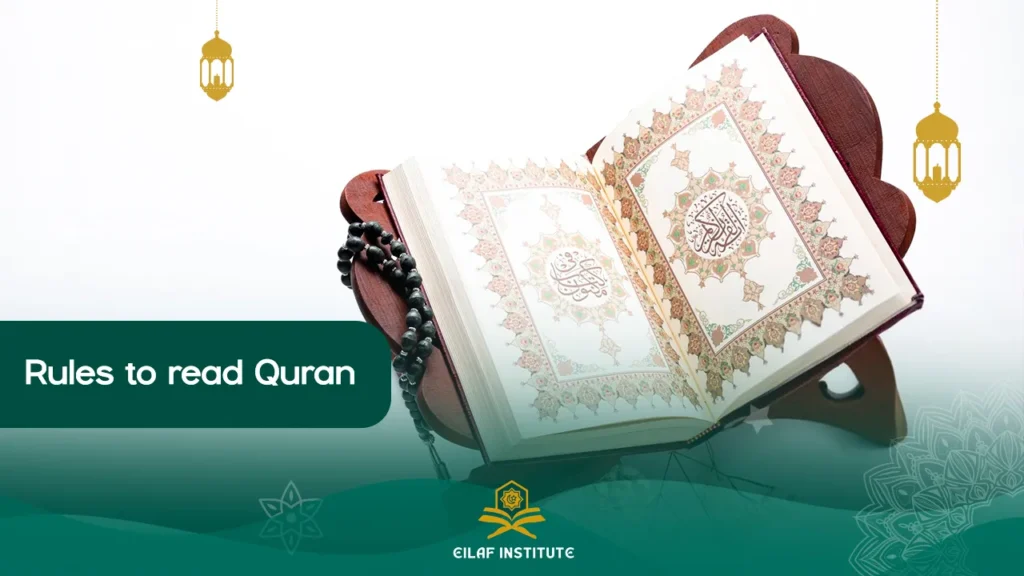There are Rules To Read Quran. Many Muslims don’t know about the signs located in the holy Quran before, after, and between the verses.
Muslims must know about them and their meaning and also must know what the manners and rules are to read verses of the holy Quran to read it properly.
The manners of reading the holy Quran
There are manners Muslims must do to read the holy Quran
- Perform Wudu before touching the holy Quran
- While reading Quran, Muslims must sit in a respectful manner
- Put the holy Quran in a high position
- Hold the holy Quran with your right hand
- Recite the bismillah
- Recite the holy Quran at a slow pace
- Follow the Tajweed principles
- Don’t talk with anyone while recitation
Rules To Read Quran
1- The Conclusion of Verse
The most important rules for reading the quran is this one. At every ayat in the holy Quran, Muslims will see this sign because this sign means that this verse is finished, and after it, a new verse.
If Muslims want to stop reading, they must reach this sign to finish reading the holy Quran.
بِسْمِ اللَّهِ الرَّحْمَنِ الرَّحِيمِ
(In the name of Allah, the Most Gracious, the Most Merciful.)
2- مـ – The Compulsory Stop
Meen (م) is one of the letters in the holy Quran that means stop; it can be at the end of a word or the beginning, but Muslims must stop after it because it is one of the tajweed rules in reciting the holy Quran, so Muslims must stop because the meaning of the verses can change when connecting the words.
For example:
وَإِنَّ اللَّهَ سَمِيعٌ عَلِيمٌ م
(And indeed, Allah is All-Hearing, All-Knowing.)
(Surah Al-Baqarah 2:257)
The pause here is mandatory, as connecting the words would alter the meaning.
3- ط – The Absolute Pause
The letter Tah (ط) means in the holy Quran that it is recommended to stop to take a small rest or take a breath then continue reciting, and this is helpful for people who recite a lot of verses they will need, they can take the rest from this sign.
Example:
إِنَّ اللَّهَ كَانَ غَفُورًا رَحِيمًا ط
(Indeed, Allah is Forgiving and Merciful.)
(Surah Al-Ahzab 33:43)
Read also about : how to learn quran fast
4- ج – The Permissible Stop
The letter Geem (ج) means the permissible stop, so Muslims can stop at this point and take a short or long rest to continue after a while. Also, this means that the verse’s meaning is complete.
Example:
إِنَّ اللَّهَ يَأْمُرُ بِالْعَدْلِ وَالإِحْسَانِ وَإِيتَاءِ ج
(Indeed, Allah commands justice, the doing of good, and liberality.)
(Surah An-Nahl 16:90):
5-ز – Continue Reading – Waqf e Mujawwaz
This sign means that Muslims can’t stop at this time, so it is recommended to continue reciting the verse, but the stop is allowed.
Example:
فَذُوقُوا بِمَا نَسِيتُمْ ز
(So taste [the punishment] because you forgot the meeting of this Day.)
(Surah As-Sajda 32:14)
6- ص – The Licensed Pause – Waqf e Murakh-Khas
It is recommended to continue reading but Muslim can stop for a necessity, like he needs to rest or take his breath, he can wait until he reach the sign, then take his breath and rest if the Muslim wants that.
That is one of quran rules you need to know and follow.
Example:
وَإِذَا قَرَأْتَ الْقُرْآنَ ص
(And when you recite the Quran…)
(Surah An-Nahl 16:98)
7- صلي – Preference for Continuation – Al-Wasl Awlaa
This sign means that it’s recommended to continue reading; but you can stop if you need so.
Example:
وَالْتَمَسُوا فِي مَا رَزَقَكُمُ اللَّهُ صلي
(And seek what Allah has bestowed upon you.)
(Surah Al-Baqarah 2:231):
8- ق – Better not to Stop—Qeela ‘Alayhil-Waqf
This sign means that Muslims shouldn’t stop at this point and should continue, although there are differing opinions on whether to stop reciting the verse or not.
So, it is considered one of the most important Rules To Read Quran.
Example:
لَا تَجْزَعُوا ق
(Do not grieve.)
(Surah At-Tawbah 9:51):
Read also about : how long does it take to learn to read quran
تُرَم -9 – hibernate Qaul -The Permissible Pause:
This implies that while carrying on is superior, pausing briefly is permissible. You get the flexibility of resting for some time without losing the context.
Example:
وَعَادٌّ فِرْعَوْنُ تُرَم
(And ‘Aad and Pharaoh…)
(Surah Al-Ahqaf 46:21)
قف -10 Qif – Anticipation Mark:
This mark offers an extended pause similar to that of the period. This indicates a break in thought-just as it would with a period, even if the sentence may indicate continuing.
Example:
وَمَا قَدَرُوا اللَّهَ حَقَّ قَدْرِهِ ق
(And they did not give Allah His due measure.)
(Surah Al-An’am 6:91)
س-11 Saktah – Silence Symbol:
It is a small stop where you are not required to take a breath. It often creates a rhythm, and sometimes it gives emphasis to the parts in the text.
Example:
قُلْ هُوَ اللَّهُ أَحَدٌ س
(Say, “He is Allah, [Who is] One.”)
(Surah Al-Ikhlas 112:1)
وقفتہ- 12 (Waqfah – The Longer Pause):
This symbol indicates a longer pause. You get an opportunity to collect your thoughts while the link to the overall message of the verse continues.
Example:
فَصَبْرٌ جَمِيلٌ وَاللَّهُ الْمُسْتَعَانُ وقفته
(So patience is most fitting, and Allah is the one sought for help.)
(Surah Yusuf 12:18):
لا -13 – No Need of Stopping
This indicates negation. Most importantly, it should not take the breath; it establishes continuity on the recitation.
Example:
وَمَا لَنَا أَلَا نُؤْمِنُ لا
(And why should we not believe?)
(Surah Al-Ma’idah 5:84)
ك -14 (Kadhaalik meaning as Previous Sign):
This sign suggests that the subsequent sentence carries a meaning similar to the previous ones and you are allowed to continue on without pause.
Example:
فَذُوقُوا بِمَا نَسِيتُمْ ك
(So taste [the punishment] because you forgot the meeting of this Day.)
(Surah As-Sajda 32:14)
Read also about : How to learn quran for beginners?
15- ∴ ∴ – The Embracing Stop
“Mu’anaqah” is an Arabic word, which literally means “embracing” or “entwining.” this is a sign that signifies about stopping at either of the triplet included in it, with no discontinuation simultaneously. It adds eloquent and beautiful language to the Quran and makes it poetic and rhythmic.
Example:
قُلْ أَعُوذُ بِرَبِّ النَّاسِ ∴ ∴
(Say, “I seek refuge in the Lord of mankind.”)
(Surah An-Nas 114:1)
16- The Prophet’s halt وقف النبی – The Pause of the Prophet (PBUH)
It means “Waqf-un-Nabi” or “the pause of the Prophet.” During Quranic recitation, this word refers to a Sunnah. The Sunnah refers to the actions of Prophet Muhammad PBUH.
What that entails is that he had many ways through which he used to recite the Holy Quran, which included stopping at a particular place.
According to the Prophet’s tradition himself, such stops were his Sunnah and hence did not carry any sign.
Example:
مَا كَانَ لِلنَّبِيِّ وَالَّذِينَ آمَنُوا
(It was not for the Prophet and those who believed.)
(Surah Al-Ahzab 33:36)
17-. وقف غفران – The Sign of Supplication
“Waqf Al-Ghufraan” is an Arabic term that stands for “a pause for forgiveness.” This term recurs at many places in the Islamic literature pieces, in the Holy Quran, where it advises the reader to pause and ask for forgiveness from Allah.
Whenever the above sign appears, the readers are invited to pause and offer a short prayer for forgiveness so that one may ponder over what he has just read and pray for forgiveness of his sins.
Example:
رَبَّنَا لَا تُؤَاخِذْنَا وقف غفران
(Our Lord, do not impose blame upon us.)
(Surah Al-Baqarah 2:286)
18- وقف منزل – The Pause Sign of Jibrael
Waqf Al-Manzil, “pause at a designated place,” is used in the Holy Quran, indicating pauses done by the Angel Jibra’il while dictating the verses to Prophet Muhammad (PBUH).
These pauses, marked by this very symbol of Waqf Al-Manzil, are indications for the readers to pause and ponder, as if imitating the experience of divine revelation, this is one of the most important Rules To Read Quran.
Example:
فَصَبْرٌ جَمِيلٌ وقف منزل
(So patience is most fitting.)
(Surah Yusuf 12:18)
Etiquettes to recite the Quran
After knowing the rules to read quran, it is time to etiquettes to recite the Quran
- Be Clean and Pure
Before reciting, it’s recommended to be in a state of wudu (ablution), though it’s not strictly required. Just ensure you’re clean and your surroundings are too. - Handle the Quran with Respect
Treat the Quran with care. Don’t place it on the floor, and always hold it with clean hands. It’s best to keep it in a place that shows respect, like a shelf or high spot. - Wear Modest Clothing
While there’s no strict dress code, it’s best to wear clean and modest clothing, especially if you’re reciting in a mosque or around others. - Face the Qibla (if possible)
When you can, face the qibla (the direction of Makkah) while reciting, though it’s not a must.
Book now and learn to read quran online
- Use Proper Pronunciation
Try to recite with correct pronunciation, especially when it comes to Tajweed. If you’re not familiar with it, it’s a good idea to listen to a skilled reciter or take lessons. - Start with “Bismillah”
Before you start, say “Bismillah ir-Rahman ir-Rahim” (In the name of Allah, the Most Merciful, the Most Compassionate). - Reflect on What You’re Saying
Try to understand the meaning of the verses. The Quran isn’t just for reading—it’s a guide for life. When you take time to reflect on the verses, it brings a deeper connection. - Be Humble
Approach the Quran with a humble heart. This is Allah’s word, so treat it with respect, and avoid rushing through it. - Stay Focused
When reciting, try not to talk or get distracted by other things. Give your full attention to the words of the Quran. - Pause After Each Verse
After finishing a verse, take a moment to pause and reflect. This helps you absorb what you’ve read rather than rushing through it. - Avoid Multitasking
Try to set aside time just for reciting the Quran. It’s your time to connect with it, so avoid distractions like your phone or the TV. - Ask for Guidance
Before you begin, make a small du’a asking Allah to guide you. After you finish, pray for understanding and blessings. - Make it a Habit
It’s better to recite a little bit every day than to do a lot all at once. Consistency matters more than quantity. - Prostrate (Sujood) When Required
If you come across a verse that requires you to prostrate, take a moment to do it. It’s a beautiful way to humble yourself before Allah. - Be Respectful When Others Recite
If someone else is reciting, give them your full attention. Avoid talking or interrupting so everyone can listen in peace.
Get Sessions on Quranic Reading
Are you ready to enhance your understanding of Quranic recitation and the rules that govern it? Book your session at Eilaf Institute and learn more about proper Quranic reading, signs, and Tajweed principles.

